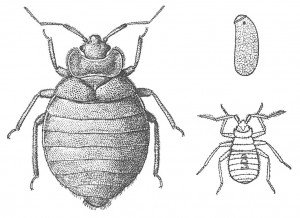
The era of insects began about 400 million years ago. However, the direct ancestors of bed bugs, plant lice and reduviids, have only been found as fossils in approx. 300 million years old layers. The bloodsuckers didn’t have any opportunities until the warm-blooded mammals and birds came approx. 200 million years ago.
But when were humans burdened with these nasty bloodsuckers?
It is possible to get an idea by studying what other kind of animals are plagued by bed bugs. Today, about 75 different species of bed bugs are known. More than half of them have only been known to science fairly recently. This is due to an extensive collection of work carried out by a team of zoologists from Berkeley University in California, a job that led them to caves, to palm trees and to bird’s nests on rock ledges around the globe.
It turned out that bed bugs are exclusively associated with bats and certain types of birds and then to humans of course. It may seem to be a strange sample, but it makes sense with their particular lifestyles. In contrast to the “real” parasites such as head lice, which spend all their lives in their host animals, bed bugs are not constantly living in their blood donor. When they are not sucking blood, they do not stay in, but near the host. They can therefore only survive in animals that have a permanent nest, a refuge or a home that they continue to return to.
All indications are that bats are bed bugs’ original host animals. More than half of all bed bug species are in fact associated with bats, and among them the types that are the most original in terms of their appearance.
It is tempting to imagine that when some of our ancestors perhaps a few hundred thousand years ago, shared housing with bats in caves in the rocks, there were bat bugs which discovered that people are good hosts. They gradually developed into the species we know today as the common bed bug, which has since followed us and adapted to a life in the different types of housing we have made our home. (fig.xx)
In addition, it is still possible to experience being bitten by bat bugs if you share a house with a colony of bats.
There is also a suggestion as to where in the World the common bed bug has evolved. This must have happened in a warm area. Bed bugs thrive best at temperatures of between 25 and 28 degrees Celsius and if the temperature gets below 13 degrees Celsius, their development comes to a standstill.
It is therefore concluded that our bed bugs have evolved in the dry, warm regions of the Middle East. Today, common bed bugs can be encountered across the globe.




